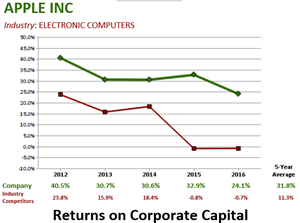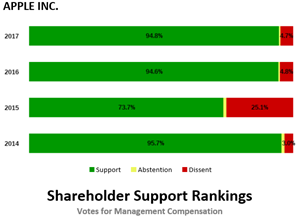THE
WALL STREET JOURNAL.
Markets
iPhones and Children Are a Toxic Pair, Say Two Big Apple Investors
Two activist
shareholders want Apple to develop tools and research effects on
young people of smartphone overuse and addiction
|

Teens took a group selfie with a smartphone in
New York’s Times Square on Dec. 1. PHOTO: DREW ANGERER/GETTY
IMAGES |
By
David Benoit
Updated Jan. 7, 2018 7:28 p.m. ET
The iPhone has made
Apple Inc. and Wall Street
hundreds of billions of dollars. Now some big shareholders are asking
at what cost, in an unusual campaign to make the company more socially
responsible.
A leading activist investor and a pension fund are saying the
smartphone maker needs to respond to what some see as a growing public-health
crisis of youth phone addiction.
Jana Partners LLC and the California State Teachers’ Retirement
System, or Calstrs, which control about $2 billion of Apple shares, sent
a letter to Apple on Saturday urging it to
develop new software tools that would help parents control and limit phone use
more easily and to study the impact of overuse on mental health.
The Apple push is a preamble to a new several-billion-dollar fund
Jana is seeking to raise this year to target companies it believes can be better
corporate citizens. It is the first instance of a big Wall Street activist
seeking to profit from the kind of social-responsibility campaign typically
associated with a small fringe of investors.
Adding splash, rock star Sting and his wife, Trudie Styler, will
be on an advisory board along with Sister Patricia A. Daly, a nun who
successfully fought
Exxon Mobil Corp. over environmental
disclosures, and Robert Eccles, an expert on sustainable investing.
The Apple campaign would be unusual for an activist like Jana,
which normally urges companies to make financial changes. But the investors
believe that Apple’s highflying stock could be hurt in coming decades if it
faces a backlash and that proactive moves could generate goodwill and keep
consumers loyal to Apple brands.
“Apple can play a defining role in signaling to the industry that
paying special attention to the health and development of the next generation is
both good business and the right thing to do,” the shareholders wrote in the
letter, a copy of which was reviewed by The Wall Street Journal. “There is a
developing consensus around the world including Silicon Valley that the
potential long-term consequences of new technologies need to be factored in at
the outset, and no company can outsource that responsibility.”
Obsessive teenage smartphone usage has sparked a debate among
academics, parents and even the people who helped create the iPhone.
|

Two teenage boys use smartphones in Vail, Colo.,
in June 2017. Photo:
Robert Alexander/Getty Images |
Some have raised concerns
about increased rates in teen depression and suicide and worry that
phones are replacing old-fashioned human interaction. It is part of a
broader re-evaluation of the effects on society of technology
companies such as Google and
Amazon.com Inc. and social-media
companies like
Facebook Inc. and
Snap chat owner Snap Inc., which
are facing questions about their reach into everyday life.
Apple hasn’t offered any public guidance to parents on how to
manage children’s smartphone use or taken a position on at what age they should
begin using iPhones.
Apple and its rivals point to features that give parents some
measure of control. Apple, for instance, gives parents the ability to choose
which apps, content and services their children can access.
The basic idea behind socially responsible investing is that good
corporate citizenship can also be good business. Big investors and banks,
including TPG,
UBS Group AG and
Goldman Sachs Group Inc. are making bets on
socially responsible companies, boosting what they see as good actors and
avoiding bad ones.
Big-name activists increasingly view bad environmental, social or
governance policies as red flags. Jana plans to go further, putting its typical
tools to work to drive change that may not immediately pay off.
Apple is an ambitious first target: The combined Jana-Calstrs
stake is relatively small given Apple’s nearly $900 billion market value. Still,
in recent years Apple has twice faced activists demanding it pare its cash
holdings, and both times the company ceded some ground.
Chief Executive Tim Cook has led Apple’s efforts to be a more
socially responsible company, for instance on environmental and immigration
issues, and said in an interview with the New York Times last year that Apple
has a “moral responsibility” to help the U.S. economy.
Apple has shown willingness to use software to address
potentially negative consequences of phone usage. Amid rising concerns about
distracted driving, the company last year updated its software with a “do not
disturb while driving” feature, which enables the iPhone to detect when someone
is behind the wheel and automatically silence notifications.
The iPhone is the backbone of a business that generated $48.35
billion in profit in fiscal 2017. It helped turn Apple into the world’s largest
publicly listed company by market value, and anticipation of strong sales of its
latest model, the iPhone X, helped its stock rise 50% in the past year. Apple
phones made up 43% of U.S. smartphones in use in 2016, according to
comScore , and an estimated 86 million
Americans over age 13 own an iPhone.
Jana and Calstrs are working with Jean M. Twenge of San Diego
State University, who chronicled the problem of what she has dubbed the “iGen”
in a book that was previewed in a widely discussed article in the Atlantic
magazine last fall, and with Michael Rich of Harvard Medical School and Boston
Children’s Hospital, known as “the mediatrician” for his work on the impact of
media on children.
The investors believe both the content and the amount of time
spent on phones need to be tailored to youths, and they are raising concern
about the public-health effects of failing to act. They point to research from
Ms. Twenge and others about a “growing body of evidence” of “unintentional
negative side effects,” including studies showing concerns from teachers. That
is one reason Calstrs was eager to support the campaign, according to the
letter.
The group wants Apple to help find solutions to questions like
what is optimal usage and to be at the forefront of the industry’s
response—before regulators or consumers potentially force it to act.
The investors say Apple should make it easier and more intuitive
for parents to set up usage limits, which could head off any future moves to
proscribe smartphones.
The question is “How can we apply the same kind of public-health
science to this that we do to, say, nutrition?” Dr. Rich said in an interview.
“We aren’t going to tell you never go to Mickey D’s, but we are going to tell
you what a Big Mac will do and what broccoli will do.”
—Tripp Mickle and Betsy Morris contributed to this article.
Write to
David Benoit at
david.benoit@wsj.com
Appeared in the January 8,
2018, print edition as 'Investors Prod Apple On Child iPhone Use.'



